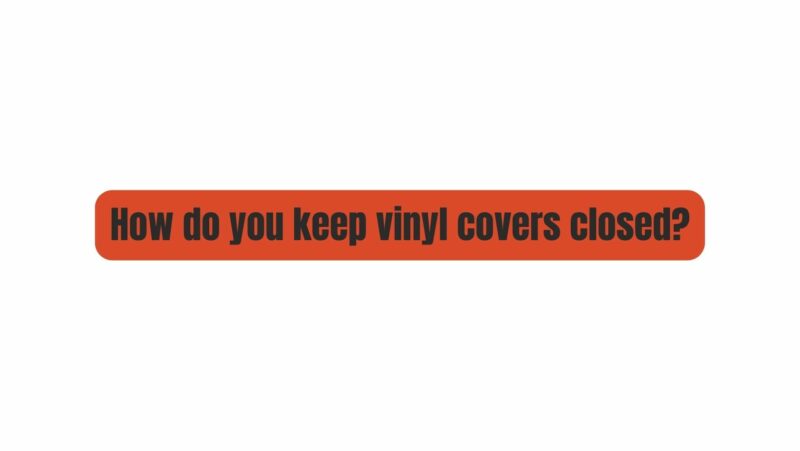For vinyl enthusiasts and collectors, the tactile experience of handling records is an integral part of the music journey. Vinyl records, with their iconic covers and accompanying artwork, offer a unique connection to the music they contain. However, keeping vinyl covers closed and well-preserved is crucial to maintaining the integrity of your record collection. In this comprehensive guide, we will explore various methods and tips for ensuring that your vinyl covers remain closed, protecting both the records and their valuable cover art.
The Importance of Proper Cover Closure
Preserving the condition of vinyl covers goes beyond aesthetics; it plays a significant role in maintaining the overall quality and value of your record collection. Here’s why keeping vinyl covers closed is essential:
- Protection: Closed covers shield records from dust, dirt, and potential damage, ensuring that the vinyl itself remains in optimal condition.
- Visual Appeal: An intact and well-preserved cover enhances the visual appeal of your record collection. Aesthetically pleasing covers contribute to the overall experience of vinyl records.
- Collector’s Value: Vinyl records, especially rare or vintage ones, can hold significant collector’s value. A well-preserved cover is a key factor in determining a record’s overall condition and worth.
Factors Affecting Cover Closure
Before diving into methods for keeping vinyl covers closed, it’s essential to understand the factors that can affect cover closure and condition:
- Wear and Tear: Over time, the spine and edges of record covers may show signs of wear and tear, making it challenging to keep them closed.
- Humidity: High humidity levels can cause covers to warp or expand, leading to difficulties in keeping them closed.
- Storage Position: The way records are stored—either vertically or horizontally—can affect the condition of the covers and their ability to remain closed.
- Cover Material: The type of material used for the cover, such as cardboard or paperboard, can impact its durability and susceptibility to damage.
Now, let’s explore various methods for keeping your vinyl covers closed and well-maintained.
Methods for Keeping Vinyl Covers Closed
- Polythene Outer Sleeves: One of the most effective methods for protecting and keeping vinyl covers closed is to use polythene outer sleeves. These clear plastic sleeves slide over the entire cover, providing a protective barrier against dust, moisture, and wear. They are available in various sizes to accommodate different cover dimensions. Not only do outer sleeves keep covers closed, but they also enhance the overall protection of the record.
- Inner Plastic Sleeves: For added protection and to prevent wear on the inner sleeve, consider using plastic inner sleeves. These sleeves not only protect the vinyl from scratches but also help in maintaining the condition of the cover by reducing friction when inserting and removing the record.
- Storage in Polythene Dust Jackets: To further protect the cover and maintain closure, consider storing records in polythene dust jackets within the outer sleeve. These jackets prevent covers from coming into contact with dust and other potential sources of damage.
- Record Clamps or Weights: For records that are prone to cover warping or have stubborn edges that won’t stay closed, vinyl enthusiasts often use record clamps or weights. These devices gently hold the cover in place, ensuring it remains closed during storage and playback. Be sure to choose options that won’t damage the cover or leave impressions.
- Proper Storage Position: How records are stored can also impact the condition of their covers. Storing records vertically, like books on a shelf, can alleviate stress on the spine and edges, helping covers remain closed.
- Regular Maintenance: Periodically inspect your vinyl covers for signs of wear, tears, or damage. Address any issues promptly to prevent further deterioration.
- Adjustable Shelving: If you have control over your storage space, consider using adjustable shelving units that allow you to customize the spacing between records. This ensures that records are stored without undue pressure on the covers, helping them stay closed.
- Humidity Control: Maintaining proper humidity levels in your storage area (ideally between 40% and 60%) can prevent cover warping and expansion, helping covers maintain their shape and closure.
Tips for Record Collectors
In addition to the methods mentioned above, here are some valuable tips for record collectors to keep in mind:
- Clean Hands: Always handle your records with clean, dry hands to prevent the transfer of oils, dirt, or other contaminants to the covers.
- Regular Cleaning: Periodically clean the covers of your vinyl records using a soft, lint-free cloth or a brush designed for the purpose. This helps remove dust and prevents it from settling in the cover seams.
- Rotate Records: If you have a collection of records that you rarely play, consider periodically rotating them to ensure that covers do not become permanently creased or misshapen due to long-term storage.
- Storage Environment: Choose a storage environment that is free from direct sunlight and extreme temperature fluctuations, as these can damage both covers and records.
- Catalog and Document: Maintain a catalog or inventory of your record collection, noting any unique features, such as limited editions, autographs, or notable cover artwork. This information can be valuable for future reference or if you decide to sell or trade records.
Conclusion
Keeping vinyl covers closed is an essential aspect of preserving the condition and value of your record collection. By implementing the methods and tips outlined in this guide, you can ensure that your vinyl records and their covers remain in top-notch condition for years to come. Remember that proper care and attention to detail not only enhance the longevity of your collection but also contribute to the overall enjoyment and visual appeal of vinyl records as a cherished medium for music and art.


